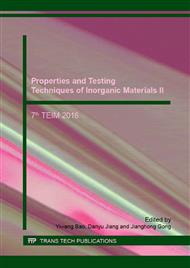p.500
p.505
p.510
p.515
p.521
p.527
p.532
p.537
p.542
Shrinkage Properties of Cement-Silica Fume Blended Pastes in Early Age
Abstract:
The cement-silica fume blended pastes were prepared with different silica fume (SF) dosages of 0%, 5%, 10%, and 15% at different water-binder ratios (W/B) of 0.4 and 0.5. The autogenous shrinkage (AS) and the drying shrinkage (DS) of the paste samples in the hydration period of 7d (168 hours) were measured by a new measurement technique to explore the influence of W/B and silica fume incorporation on the shrinkage in early age. The study results can provide reference for high performance concrete mix design.It is found that ether the AS or the DS of the paste samples shows a similar pattern, and the AS development with hydration time appeared a temporary expansion period after a rapid growth, especially in the samples at a higher W/B or with a lower SF content. However, the DS development did not occur obvious expansion period.Three development trends were obtained for the factors of W/B and SF content. 1) the AS and DS of the pastes mainly occurred in early ages. The lower W/B, the shorter the rapid growth periods, and the higher the shrinkage ratio of 1d to 7d. For the pastes with W/B of 0.4, the AS grew rapidly in 1d and the DS grew rapidly in the first 10h, and the AS value in 1d reached to 63.6% of 7d, and the DS value reached to 62.1% of 7d in the paste with SF of 10%. For the pastes with W/B of 0.5, the rapid growth periods of the AS and DS respectively extended to 30~33h and 12h, and the AS value in 1d reached to 60.0% of 7d, and the DS value reached to 57.2% of 7d in the paste with SF of 10%. 2) The lower W/B, the higher the shrinkage ratio of the AS to the DS. When the SF dosage is 10%, the ratio of the AS value to the DS value of 7d is 21.66%~21.15% for W/B of 0.4, and only 6.06%~5.78% for the W/B of 0.5. 3) the higher SF content results in the higher AS in cement-SF blended pastes. For the pastes with W/B of 0.4, the ratio of the AS to the DS increased from 6.98% to 30.16% with the increase of content of SF from 5% to 15% in 1d, from 15.1% to 28.19% in 3d, from 16.78% to 26.16% in 7d.
Info:
Periodical:
Pages:
521-526
Citation:
Online since:
January 2017
Authors:
Keywords:
Price:
Сopyright:
© 2017 Trans Tech Publications Ltd. All Rights Reserved
Share:
Citation:


